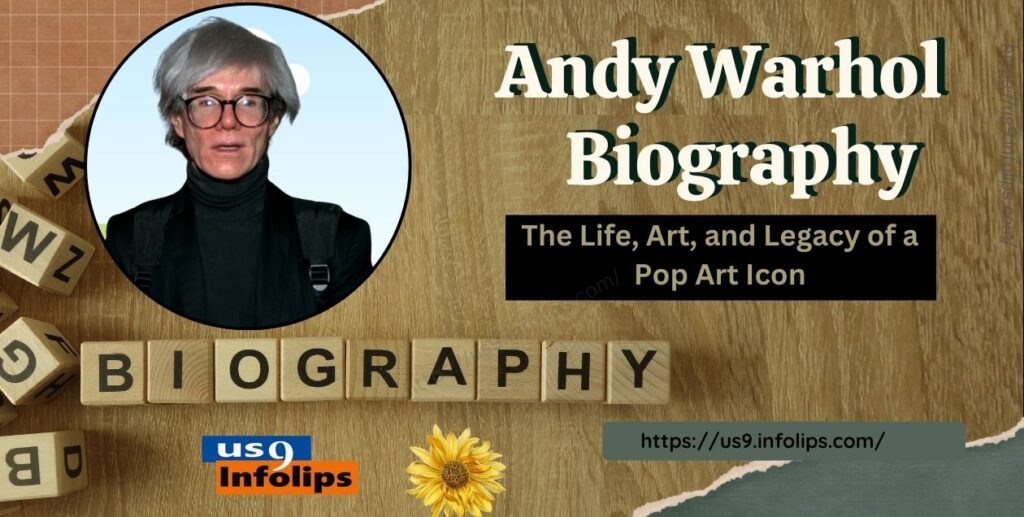Andy Warhol Biography : The Life, Art, and Legacy of a Pop Art Icon
Andy Warhol Biography : The Life, Art, and Legacy of a Pop Art Icon
Introduction:
Andy Warhol, a pivotal figure in the Pop Art movement, revolutionized the art world with his unique depictions of consumer goods and celebrities. From his iconic Campbell’s Soup Cans to his vibrant Factory studio, Warhol’s influence extends beyond art into film, music, and popular culture. This article explores his extraordinary life, groundbreaking works, and lasting legacy.
Table of Contents
Early Life and Education:
Andy Warhol was born on August 6, 1928, in Pittsburgh, Pennsylvania. He was the youngest of three children in a working-class family of Slovakian immigrants. Warhol showed an early interest in art and attended the Carnegie Institute of Technology (now Carnegie Mellon University), where he studied commercial art.
Commercial Artist Beginnings:
After graduating in 1949, Warhol moved to New York City, where he began his career as a commercial artist. His unique blotted-line technique and whimsical style gained him recognition, and he quickly became one of the most successful commercial illustrators of the 1950s.
Pop Art Pioneer:
In the early 1960s, Warhol transitioned from commercial art to fine art, becoming a leading figure in the Pop Art movement. He is best known for his iconic depictions of consumer goods and celebrities, such as the Campbell’s Soup Cans, Marilyn Monroe, and Coca-Cola bottles. Warhol’s work challenged traditional boundaries between high and low art.
The Factory:
Warhol established his studio, known as The Factory, in 1962. It became a vibrant hub for artists, musicians, writers, and celebrities. The Factory was renowned for its creative atmosphere and avant-garde parties. It was here that Warhol produced many of his most famous works and collaborated with a diverse group of artists.
Film and Multimedia Projects:
In addition to his painting and printmaking, Warhol ventured into film-making. Between 1963 and 1968, he made over 60 films, including “Chelsea Girls” and “Empire.” Warhol’s films were known for their experimental nature and often featured extended scenes and unconventional storytelling.
Exploration of Different Mediums:
Warhol was not limited to traditional art forms. He also delved into photography, sculpture, and music production. He was a manager and producer for the rock band The Velvet Underground, and his innovative album cover designs, such as the banana cover for their debut album, became iconic.
The Shooting Incident:
On June 3, 1968, Warhol was shot by Valerie Solanas, a radical feminist and writer who had been a part of The Factory scene. The attack left Warhol critically injured, and he underwent multiple surgeries. The incident profoundly impacted his life and work, leading to a more somber and introspective period in his art.
Later Years and Legacy:
In the 1970s and 1980s, Warhol continued to produce art and expand his influence. He created portraits of famous figures, engaged in television projects, and published several books. Warhol’s contributions to art and culture were widely recognized, and he became a global icon. His innovative approach and exploration of consumerism, celebrity, and media left a lasting mark on contemporary art.
Death and Posthumous Recognition:
Andy Warhol died on February 22, 1987, following complications from gallbladder surgery. His legacy endures through the extensive body of work he left behind and the continued influence of his ideas on modern art and popular culture. The Andy Warhol Museum in Pittsburgh, which opened in 1994, stands as a testament to his enduring impact and showcases his life and works.
9 Best Facts About Andy Warhol
- Campbell’s Soup Cans:
Warhol’s 1962 series “Campbell’s Soup Cans” is one of his most famous works. He painted 32 canvases, each depicting a different variety of the soup, and it became a defining image of the Pop Art movement. - Celebrity Portraits:
Warhol was renowned for his portraits of celebrities. His silkscreen prints of Marilyn Monroe, Elvis Presley, and Elizabeth Taylor are some of the most iconic images in contemporary art. - The Factory:
Warhol’s studio, The Factory, was a legendary New York City hub for artists, musicians, and celebrities. It was a creative space where Warhol produced his art and hosted infamous parties. - Film Contributions:
Warhol made significant contributions to avant-garde cinema, producing over 60 films. His experimental works, such as “Sleep” (1963) and “Empire” (1964), pushed the boundaries of conventional film-making. - Endorsement and Advertising:
Warhol blurred the lines between art and commerce. He once famously said, “Making money is art,” and he created advertisements and brand endorsements as part of his artistic practice. - Album Covers:
Warhol designed iconic album covers, most notably for The Velvet Underground’s debut album, which featured a banana that could be peeled to reveal a flesh-colored fruit underneath. - Shooting Incident:
In 1968, Warhol was shot by Valerie Solanas, a radical feminist who had appeared in one of his films. Warhol survived the attack but suffered physical and emotional scars for the rest of his life. - Television Presence:
Warhol ventured into television with shows like “Andy Warhol’s TV” and “Andy Warhol’s Fifteen Minutes.” These programs featured interviews with celebrities and glimpses into the artist’s eclectic world. - The Andy Warhol Museum:
Located in his hometown of Pittsburgh, Pennsylvania, The Andy Warhol Museum is the largest museum in the United States dedicated to a single artist. It houses an extensive collection of his works and archives.
9 Unknown Facts About Andy Warhol
- Early Health Struggles:
As a child, Warhol suffered from Sydenham’s chorea, a neurological disorder that causes involuntary movements. This illness kept him bedridden for long periods, during which he developed a passion for drawing and listening to the radio. - Art Teacher Influence:
One of Warhol’s early influences was his high school art teacher, Joseph Fitzpatrick, who recognized his talent and encouraged him to pursue a career in art. - Foot Fetish:
Warhol had a fascination with feet and shoes. This interest is evident in his early commercial work, where he created numerous shoe illustrations for fashion magazines. - Religious Devotion:
Despite his avant-garde persona, Warhol was a devout Catholic. He regularly attended church, and his faith influenced many of his works, including his “Last Supper” series. - Time Capsules:
Warhol created over 600 “time capsules” throughout his life. These were cardboard boxes filled with items from his daily life, including letters, newspapers, photographs, and personal mementos. - Secret Paintings:
Warhol experimented with abstract art in the 1980s, creating a series of abstract paintings that were not widely known or exhibited during his lifetime. These works were a departure from his more famous Pop Art style. - Magazine Founder:
Warhol founded Interview magazine in 1969, a publication that featured intimate conversations with celebrities, artists, and cultural icons. The magazine is still in circulation today. - Love of Technology:
Warhol was an early adopter of new technologies. He experimented with digital art using an Amiga computer in the 1980s, creating some of the earliest examples of digital artwork. - Influence on Fashion:
Warhol had a significant impact on the fashion world. He collaborated with fashion designers and even walked the runway for designers like Halston. His style and image influenced fashion trends and continues to inspire designers today.
9 Best Achievements and Awards of Andy Warhol
- Pioneering Pop Art:
Warhol’s most significant achievement was his role in pioneering the Pop Art movement. His works, like the Campbell’s Soup Cans and Marilyn Monroe series, redefined the boundaries of art and influenced countless artists worldwide. - The Factory:
Establishing The Factory in 1962 was a major milestone. This studio became a legendary creative hub in New York City, where Warhol produced some of his most famous works and collaborated with other artists and celebrities. - Time Capsules Project:
Warhol’s creation of over 600 time capsules filled with everyday items is a unique achievement. This project provides an intimate glimpse into his life and the era he lived in, serving as an invaluable resource for historians and art enthusiasts. - Enduring Influence:
Warhol’s influence on contemporary art and popular culture is immeasurable. His exploration of celebrity culture, consumerism, and mass production continues to resonate with artists, filmmakers, and designers. - Film and Multimedia Contributions: Warhol made significant contributions to avant-garde cinema with films like “Chelsea Girls” and “Empire.” His experimental approach to filmmaking has influenced generations of filmmakers and expanded the possibilities of the medium.
- Andy Warhol Museum:
The establishment of The Andy Warhol Museum in Pittsburgh in 1994 is a testament to his lasting legacy. It is the largest museum in the United States dedicated to a single artist and houses an extensive collection of his works and archives. - Album Cover Designs:
Warhol’s iconic album cover designs, such as the banana cover for The Velvet Underground’s debut album, have become timeless symbols in the music and art worlds. These designs have been celebrated and replicated across various media. - Books and Publications:
Warhol authored several books, including “The Philosophy of Andy Warhol” and “Popism: The Warhol Sixties,” which offer insights into his thoughts and experiences. These publications have become essential reading for those interested in his life and work. - Recognition and Awards:
Although Warhol did not receive many traditional art awards during his lifetime, his posthumous recognition is vast. He has been the subject of numerous retrospectives and exhibitions at prestigious institutions such as the Museum of Modern Art (MoMA) in New York and the Tate Modern in London, solidifying his status as one of the most influential artists of the 20th century.
9 Best Social Works Done by Andy Warhol
- Support for Emerging Artists:
Warhol’s studio, The Factory, was a creative sanctuary for young and emerging artists. He provided them with a space to work, collaborate, and gain exposure, significantly contributing to their careers. - LGBTQ+ Advocacy:
As an openly gay man during a time when LGBTQ+ rights were not widely recognized, Warhol’s visibility and success helped to challenge societal norms and promote acceptance and understanding of the LGBTQ+ community. - Cultural Commentary:
Through his art, Warhol addressed important social issues such as consumerism, celebrity culture, and the media’s influence on society. His works sparked conversations and debates, encouraging people to reflect on these critical topics. - Charitable Donations:
Warhol frequently donated his artworks to charity auctions, helping to raise significant funds for various causes, including medical research, education, and arts organizations. - AIDS Awareness:
Warhol was involved in efforts to raise awareness about AIDS during the height of the epidemic. His support for friends and artists affected by the disease, along with his participation in related events, helped to draw attention to the crisis. - Promotion of Underrepresented Artists:
Warhol used his platform to highlight the work of underrepresented artists, including women and artists of color. He collaborated with and supported artists like Jean-Michel Basquiat, helping to elevate their profiles in the art world. - Interview Magazine:
Warhol’s founding of Interview magazine in 1969 provided a platform for in-depth conversations with cultural icons, giving readers insight into the lives and thoughts of influential figures from various fields. The magazine celebrated creativity and diversity. - Public Art Projects:
Warhol participated in public art projects that made art accessible to a broader audience. His involvement in public murals and installations brought art into everyday spaces, allowing more people to engage with his work. - Education and Mentorship:
Warhol often took on the role of mentor to young artists and creatives. His guidance and support helped shape the careers of many individuals, fostering a new generation of artists who continued to push boundaries and innovate.
FAQs About Andy Warhol
Q.1: Who was Andy Warhol?
A: Andy Warhol was an American artist and leading figure in the Pop Art movement, known for his works depicting consumer goods and celebrities.
Q.2: What is Andy Warhol best known for?
A: Warhol is best known for his iconic works such as the Campbell’s Soup Cans and portraits of Marilyn Monroe.
Q.3: What was The Factory?
A: The Factory was Warhol’s New York City studio, a creative hub for artists, musicians, and celebrities, where he produced many of his famous works.
Q.4: What was Warhol’s approach to art?
A: Warhol’s art focused on mass production, consumerism, and celebrity culture, often using techniques like silkscreen printing to replicate images.
Q.5: What significant event happened to Warhol in 1968?
A: In 1968, Warhol was shot by Valerie Solanas, a radical feminist, which left him severely injured and had a lasting impact on his life and work.
Q.6: Did Andy Warhol make films?
A: Yes, Warhol made over 60 films, including notable works like “Chelsea Girls” and “Empire,” known for their experimental and avant-garde style.
Q.7: What was Warhol’s involvement with music?
A: Warhol managed and produced for The Velvet Underground and designed iconic album covers, such as the banana cover for their debut album.
Q.8: Where can you find a museum dedicated to Andy Warhol?
A: The Andy Warhol Museum, located in Pittsburgh, Pennsylvania, is dedicated to his life and works and is the largest museum in the U.S. focused on a single artist.
Q.9: How did Warhol influence contemporary art?
A: Warhol’s exploration of consumerism, celebrity culture, and his innovative use of media have had a profound and lasting impact on contemporary art, influencing countless artists and movements
.
Follow us for more captivating articles and stay connected to explore the world. Let’s embrace the power of communication and understanding.
Disclaimer: The views in this article are given with the help of information available on the net. Readers are encouraged to conduct their own research before making any decisions. The publisher disclaim any liability for any loss or damage caused directly or indirectly.

Related topics:
1. Perfect World Travel Guide
2. 9 Most Popular EV Cars in the USA
3. 9 Best Things About Apple TV 4K – Third Generation
4. Think before You Renew Amazon Prime
5. Jimmy Carter: A Great Legacy
6. Memorial Day: Honoring the Sacrifice, Celebrating Freedom
School Site :
For English grammar and lot more : Smart School Infolips
Marathi Poems: Marathi Rang











